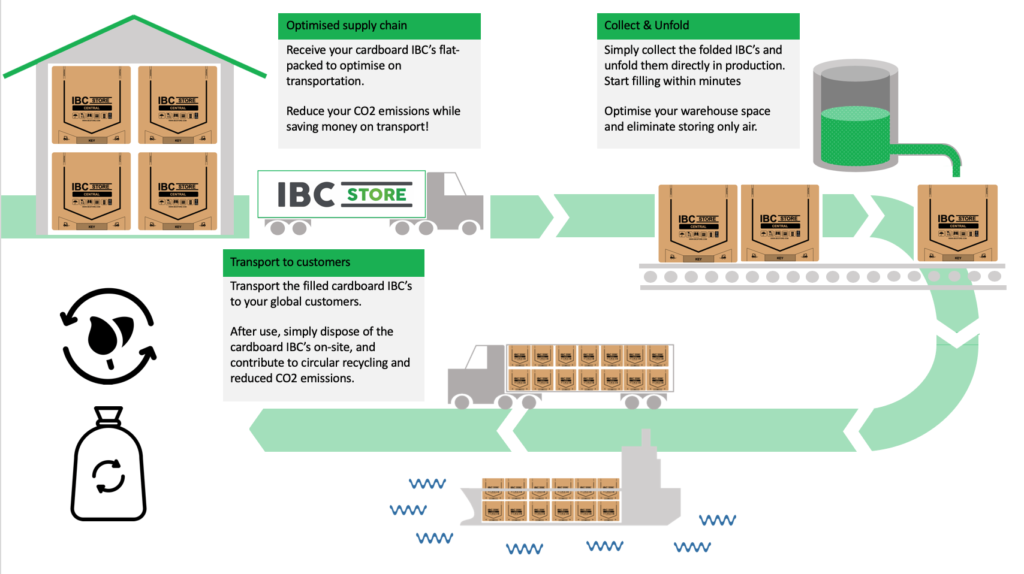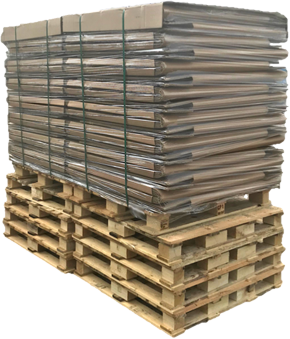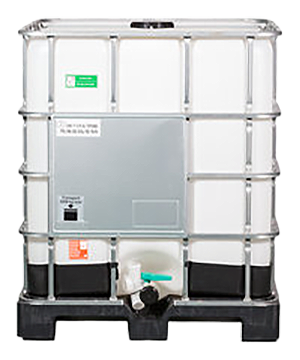INFORMATION
Sustainable IBC containers
Cardboard IBC’s are a sustainable IBC system. Reduce up to >50 % on your CO2 emissions with sustainable IBC containers.
SEPARABLE
The IBC’s contains mainly cardboard/paper and plastic. All the components in the IBC’s can be separated from each other, and disposed of in a sensible way.
SUSTAINABLE
The cardboard IBC’s are 100% separable, and this allows you to recycle each component.
ON-SITE DISPOSAL
Cardboard IBC’s can be disposed of on-site after use. Either internally or directly at your customers. No pooling is required.

IBC-store
REDUCE YOUR
CO2 FOOTPRINT
Reducing companies global CO2 footprint is worldwide target, and global companies are looking into many different options to reduce the CO2 footprint.
By changing to cardboard IBC’s your company will immediately see a reduction in your CO2 emissions. No more pooling systems, which is one of the main factors to a high CO2 emission in companies. Additionally, you save storage space and loading space with flat-packed cardboard IBC’s, which lowers your supply chain emissions.
IBC Store
CO2 emission calculation
To demonstrate the difference between CO2 emission of foldable IBC’s vs plastic IBC’s, we will use the following method. This emission example is based on a truck travelling 1,000 kilometers with 30 tons of cargo.
- Step 1: Determine the total amount of ton-kilometers. Multiply 1,000 kilometers times 30 tons, which gives us a total of 30,000 ton-kilometers.
- Step 2: Get the weight-based truck emissions factor for a freight truck. The average freight truck emits 260,39 grams of CO2 per ton-kilometer.
- Step 3: Multiply this emissions factor with the total ton-kilometer (260,39 X 30,000), which gives us a total of 7,811,700 grams of CO2.
- Step 4: Convert the total grams into metric tons. Metric tons are the standard measurement unit for corporate emissions of greenhouse gases. There are 1,000,000 grams in a metric ton. To convert our answer from step three we divide it by 1,000,000.
This gives us 7.811 metric tons of CO2 for this one move.
See following section for calculations of both foldable IBC’s and plastic IBC’s.

IBC-store
CO2 emission for foldable cardboard IBC’s
The emission calculation will be based on a total distance of 1,000 kilometers. One full load truck of foldable cardboard IBC’s will consist of 256 containers. The total cargo weight for all 256 foldable cardboard IBC’s are 7,5 tons.The CO2 emission for foldable cardboard IBC’s are: 1,95 metric tons of CO2
IBC-store
CO2 emission for plastic IBC’s
The emission calculation will be based on a total distance of 1,000 kilometers. One full load truck of plastic IBC’s will consist of 52 containers. You need 5 trucks to get 256 plastic containers delivered. The total cargo weight for all 256 plastic containers are 15,4 tons.The CO2 emission for foldable cardboard IBC’s are: 4,10 metric tons of CO2


